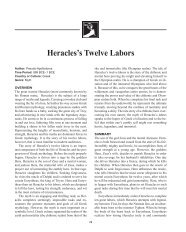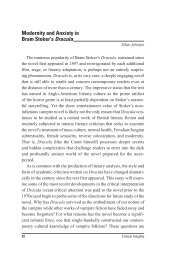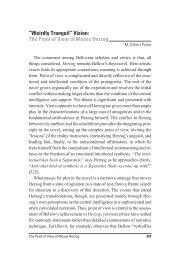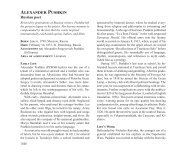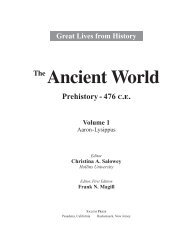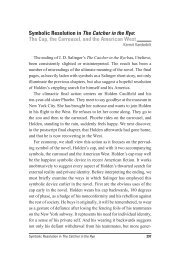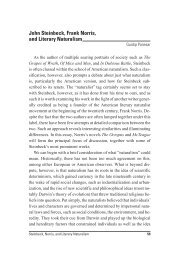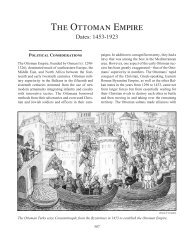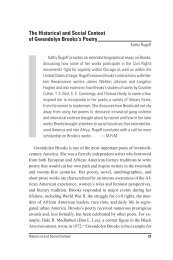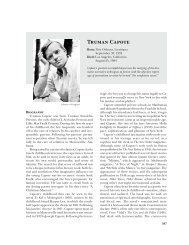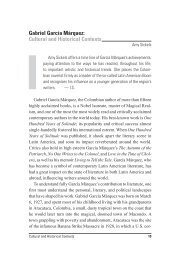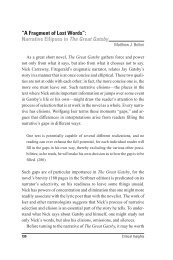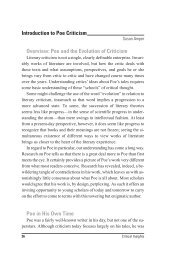You also want an ePaper? Increase the reach of your titles
YUMPU automatically turns print PDFs into web optimized ePapers that Google loves.
Critical Survey of Poetry Neruda, Pablo<br />
only with poets’ own feelings and experiences; those of<br />
other men and women hardly ever find expression in poetry.<br />
The personality of objects, of the material world,<br />
never finds a singer, except among writers such as Neruda,<br />
who are also workers. Neruda’s new purpose is to maintain<br />
his anonymity, because now “there are no mysterious<br />
shadows/ everyone speaks to me about their families,<br />
their work, and what wonderful things they do!”<br />
In the elemental odes, Neruda learns to accept and<br />
celebrate the common gift of happiness, “as necessary<br />
as the earth, as sustaining as hearth fires, as pure as<br />
bread, as musical as water.” He urges men to recognize<br />
the gifts they already possess. He sings of such humble<br />
things as eel stew, in which the flavors of the Chilean<br />
land and sea mix to make a paradise for the palate.<br />
Against those who envy his work and its unpretentious<br />
message of common humanity, Neruda responds that a<br />
simple poetry open to common people will live after<br />
him because it is as unafraid and healthy as a milkmaid<br />
in whose laughter there are enough teeth to ruin the<br />
hopes of the envious.<br />
Indeed, the language of the elemental odes is very<br />
simple and direct, but, because Neruda writes these poems<br />
in such brief, internally rhyming lines, he draws<br />
attention to the natural beauty of his Spanish, the<br />
measured rhythm of clauses, the symmetry of sentence<br />
structure, and the solid virtues of an everyday vocabulary.<br />
In the tradition of classical Spanish realism, the elemental<br />
odes require neither the magic of verbal pyrotechnics<br />
nor incursions into the subconscious to achieve<br />
a fullness of poetic vision.<br />
Extravagaria and later work<br />
After the collection Extravagaria—in which Neruda<br />
redirected his attention inward again, resolving questions<br />
of his own mortality and the prospect of never<br />
again seeing places and people dear to him—the poet’s<br />
production doubled to the rate of two lengthy books of<br />
poems every year. In response partly to the demand for<br />
his work, partly to his increased passion for writing,<br />
Neruda’s books during the last decade of his life were<br />
often carefully planned and systematic. Navegaciones y<br />
regresos (navigations and returns) alternates a recounting<br />
of his travels with odes inspired by remarkable people,<br />
places, and events. Cien sonetos de amor collects<br />
one hundred rough-hewn sonnets of love to Matilde<br />
Urrutia. Isla Negra is an autobiography in verse. Arte de<br />
pájaros is a poetic ornithological guide to Chile. Las<br />
piedras de Chile, Cantos ceremoniales (ceremonial<br />
songs), Fully Empowered, and Una casa en la arena (a<br />
house in the sand) are all-inclusive, totally unsystematic<br />
collections unified by Neruda’s bold style, a style that<br />
wanders aimlessly and confidently like a powerful river<br />
cutting designs in stone. Las manos del día (the hands of<br />
the day) and La espada encendida (the sword ignited),<br />
written between 1968 and 1970, attest Neruda’s responsiveness<br />
to new threats against freedom. Geografía<br />
infructuosa (unfruitful geography) signals Neruda’s return<br />
again to contemplate the rugged coast of Chile. As<br />
Neruda remarks in his Memoirs concerning his last decade<br />
of work, he gradually developed into a poet with<br />
the primitive style characteristic of the monolithic sculptures<br />
of Oceania: “I began with the refinements of<br />
Praxiteles and end with the massive ruggedness of the<br />
statues of Easter Island.”<br />
Other major works<br />
long fiction: El habitante y su esperanza, 1926.<br />
plays: Romeo y Juliet, pb. 1964 (translation of<br />
William Shakespeare); Fulgor y muerte de Joaquín<br />
Murieta, pb. 1967 (Splendor and Death of Joaquin<br />
Murieta, 1972).<br />
nonfiction: Anillos, 1926 (with Tomás Lago);<br />
Viajes, 1955; Comiendo en Hungría, 1968; Confieso<br />
que he vivido: Memorias, 1974 (Memoirs, 1977);<br />
Cartas de amor, 1974 (letters); Lo mejor de Anatole<br />
France, 1976; Para nacer he nacido, 1978 (Passions<br />
and Impressions, 1983); Cartas a Laura, 1978 (letters);<br />
Correspondencia durante “Residencia en la<br />
tierra,” 1980 (letters; with Héctor Eandi).<br />
Bibliography<br />
Méndez-Ramírez, Hugo. Neruda Ekphrastic Experience:<br />
Mural Art and “Canto general.” Lewisburg:<br />
Bucknell University <strong>Press</strong>, 1999. This research focuses<br />
on the interplay between verbal and visual elements<br />
in Neruda’s masterpiece Canto general. It<br />
demonstrates how mural art, especially that practiced<br />
in Mexico, became the source for Neruda’s<br />
ekphrastic desire, in which his verbal art paints visual<br />
elements.<br />
2761



